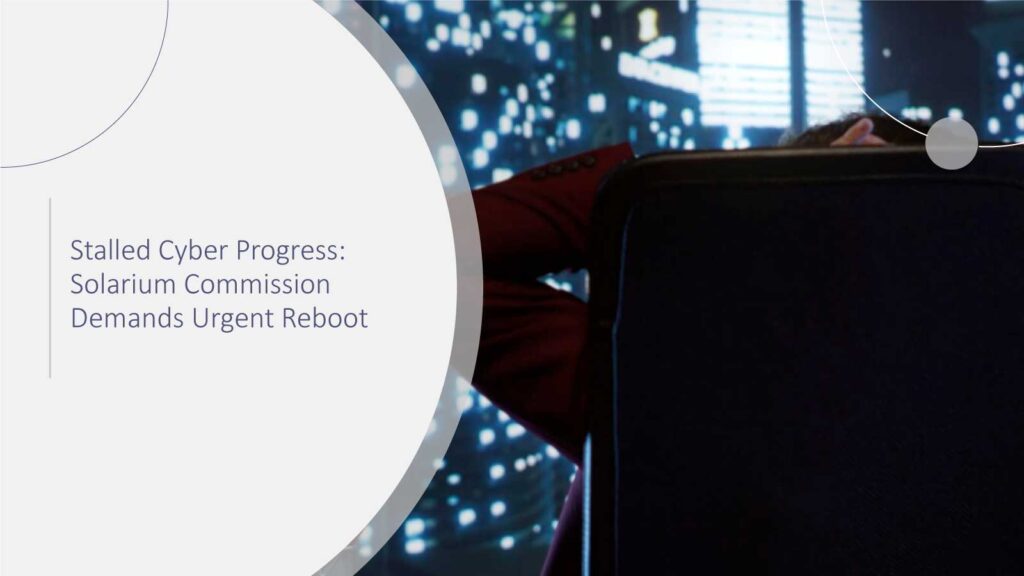In a world where cyber villains are becoming more sophisticated with each passing day and policymakers are still trying to figure out their move, the new Cyberspace Solarium Commission (CSC) report surely acts as a call to arms for Washington.
The CSC’s 2025 Annual Implementation Report, as published by the Foundation for Defense of Democracies (FDD), reveals that the U.S. defensive capability is weakening and even slipping backward in some areas. The report also indicates the country is losing its position as the world leader in cyber defense. According to Gartner’s 2025 Security & Risk Management Forecast, 82% of organizations globally expect an increase in nation-state cyber activity targeting critical infrastructure.
It’s worth pausing for a second here. The United States, usually perceived as a leading force in cyber resilience worldwide, is in fact suffering what is comparable to a midlife cybersecurity crisis after the years of positive momentum.
The data illustrate the situation much better than any title:
- 35% of the 82 original recommendations of the CSC have been fully realized – a figure that has decreased from 48% in 2024.
- 34% are close to implementation (slightly down from 32%).
- 17% are on target (a slight increase from 12%).
The report still accounts for a quarter of the recommendations whose progress has reversed and, therefore, has been termed “an unprecedented setback.”
The Warning Signs Behind the Numbers
If you have ever been in the situation of attempting to update an existing operating system and then realizing that the system is slower because of that, you will know what the situation here is. The progress that has been made is not permanent, which can be seen from the CSC’s implementation ‘decay’ trend in the report.
The report points out that reforms implemented some time ago are already diminishing in support because of the lack of money, bureaucratic deadlock, and the vacuum of leadership. With the change of employees and the priorities of the new administrations, the cybersecurity initiatives that were considered solid are now at risk of losing their way.
According to the report, the system is lagging behind the technology due to slower policy changes and less efficient communication between the two sides. The world is racing at lightning speed toward new challenges in technology, such as artificial intelligence, quantum computing, and sophisticated audio and video manipulation, while Washington is still trying to figure out its procedures for dealing with cyber disasters. McKinsey’s 2024 report on “Cybersecurity in Transition” notes that policy lag accounts for up to 40% of cybersecurity implementation delays in government sectors.
In addition, the leadership team is missing key elements: several important roles are yet to be filled. A Senate-confirmed director is still awaited by the Cybersecurity and Infrastructure Security Agency (CISA), one of the nation’s most critical defense linchpins.
This lack of leadership is more than just a symbol – it is a source of trouble for the company’s operations. As John Carberry, Chief Marketing Officer at Xcape, Inc., explains,
“It is the report which illustrates that the leadership is lacking – due to this, momentum is fading, and eventually, the CISA director is still unconfirmed. Couple all of these occurrences together, and the output is definite: recent advances will continue diminishing without the arrival of new funding, authority, and expertise. Should Washington not overhaul its cyber strategy presently, the result will be that our opponents will keep controlling the scenario.”
John’s words are strong, but they reflect the same level of urgency the CSC is expressing.
Where the Cyber Reboot Needs to Begin
The Commission’s report is not only a detailed examination of the problem but also an indication of five points to reboot the national cyber health:
Empower the National Cyber Director (NCD) – This office should be given real power over the budget and the authority to enforce the policy of cybersecurity across the federal government by coordinating it.
Reinstate CISA’s Full Funding and Workforce – Over the last few years, the money that was cut has brought down both the capability and the morale of the staff. So, it is necessary to restore them.
Rebuild Cyber Diplomacy Channels – In order to guide the formation of norms and alliances in the digital world, the State Department’s Bureau of Cyberspace and Digital Policy (CDP) has to be strengthened after being depleted.
Reestablish the Critical Infrastructure Partnership Advisory Council (CIPAC) – one of the most important public-private coordination platforms whose activities quietly ceased.
Expand and Retain Cyber Talent – The lack of cyber experts is still the main problem that prevents the United States from being strong in national defense.
All these points also reflect the bigger “layered cyber deterrence” idea, which the CSC has been supporting since the time of its foundation.
This multi-layered system, shaping behavior, denying benefits, and imposing costs, was intended to keep the enemy uncertain, the alliances strong, and the cyber defenses capable of changing. However, as the report of this year indicates, the very strategy may already be in danger of being dismantled.
Shaping Behavior: The Diplomacy Dimension
Geopolitics is something that you can’t protect against with firewalls.
By means of the State Department’s Bureau of Cyberspace and Digital Policy (CDP), the U.S. government is promoting the idea of responsible behavior of states in the digital world. But the absence of a Senate-confirmed ambassador in charge of the bureau severely limits its ability to influence global cyber norms.
Instead of being about the actual handshakes, real cyber diplomacy is about creating deterrence by means of visibility and trust. Adversarial states can, therefore, test the limits more boldly if they can do so without being challenged, and they will use every diplomatic vacuum as an opportunity to extend their digital influence. World Economic Forum (WEF) 2025 Global Cybersecurity Outlook warns that cyber diplomacy gaps could increase state-sponsored attack risks by 25% over the next two years.
If we compared cybersecurity to a chess game, the U.S. has just lost its queen.
Denying Benefits: Strengthening Partnerships
In general, the private sector is the one that is most exposed to malware and other cyber threats. For instance, in the case of ransomware, while the governments are the ones that will suffer the most, businesses will be the first to bear the loss and will have to pay the price.
One of the merits of the Office of the National Cyber Director (ONCD) is that it has been able to get various federal agencies to work together on the joint goals, which is also the main reason why CISA has been able to strengthen cooperation with the operators of the critical infrastructure and local governments.
Nevertheless, the issues resulting from non-renewal of contracts, worries over liability, and resource shortages are the ones that are putting a heavy strain on these relationships. As in life, trust in the realm of cybersecurity is very easy to lose but also hard to regain.
Among other private sector efforts, one that has been greatly facilitated by the report is the creation of Cyber Clinics, which are not only essential recovery and innovation centers that both increase the resilience of the victims and propel research and development.
However, even if we consider such an initiative as the best one, without continuous government support, it is destined to terminate prematurely.
Imposing Costs: Time to Hit Back Harder
Here is one of the discomforting truths: your resolve to act is what really gives strength to your deterrence.
The U.S. has improved its game in persistent engagement – actively cooperating with allies to tear down botnets and to disrupt the operations of ransomware groups before attacks are executed. Departments such as the Department of Defense (DoD) and the Department of Justice have gone on the offensive and taken radical cyber operations initiatives.
However, the assaults are still happening. The threat of a massive attack is being posed by threat actors supported by state entities, but at the same time, it’s criminal syndicates that are running the show. The longest that the adversaries have lasted without fear of the consequences is the fact that they are back for more.
Deterrence is, until the time when those who are launching cyberattacks get to meet coordinated, tangible, and public consequences, just a coy theory.
Why Momentum Matters Now More Than Ever
The CSC’s report stresses that the real question of what matters comes not from mere implementation but rather from the model’s institutional durability. To put it differently, cybersecurity accomplishments are not forever; they require ongoing support.
You can compare it with cybersecurity fitness. The reality is that you can’t work out hard for just one year and expect to stay in shape all the time. Once you stop training – or funding – you’ll soon see that your resilience is weak and your defenses are not up to the task.
The Commission refers to this point as “a pivotal decision point” in the United States. The subsequent steps by the administration, Congress, and industry partners will be the determining factor as to whether the country regains its cyber leadership or remains a reactive player in a setting where others call the shots.
Expert Take: The Urgency of Coordination
John Carberry of Xcape, Inc. shares that feeling, which is broadly acknowledged by the cybersecurity community:
“The report highlights leadership inadequacies, pointing out that, as momentum wanes, the CISA director nominee is still unconfirmed. When combined, the message is clear: recent progress will keep eroding in the absence of fresh funding, power, and skill“.
“If Washington doesn’t reboot its cyber game now, our adversaries will keep dictating the terms.”
His argument is not limited to the political arena. It is not about assigning blame; it is about regaining coordination.
Security in IT is not a sprint or a solo performance; rather, it should be understood as a relay race. The baton, which symbolizes the work, is the responsibility of each administration, agency, and company, and each has to carry it on without dropping it.
Conclusion
The recent Solarium Commission report serves as both a scoreboard and an alarm. The United States, while having built a robust cyber framework, is ironically signaling its fatigue through that very framework.
Whether it is the revitalization of leadership, the return of funding, the facilitation of inter-agency cooperation, or regaining the trust of the global community in the cyber domain, these are not alternative options; they are the very first things that need to be done for the survival of the U.S.
Quite simply, the cyberspace solarium commission (CSC) echoes the same idea: “We have built the framework from zero, and our biggest challenge now is to strengthen it and cover the areas where we are lacking.”
Rather than continuing with its patching routine, Washington needs to come back with a thorough reconstruction plan – it certainly has to be done before the next hacking event that will, without a doubt, make it painfully clear how costly inaction can be.
FAQs
1. What is the Cyberspace Solarium Commission (CSC)?
CSC was a congressional initiative established in the year 2019. It was aimed at the development of a comprehensive and strategic plan for the United States to deter and counter cyberattacks. The concept of “layered cyber deterrence” has been the flagship of the federal cybersecurity reforms for the last five years.
2. Why does the 2025 report matter?
The 2025 CSC report is the first to show regression in earlier reforms.
3. What are the key recommendations in the 2025 report?
The first changes they suggest are: giving more power to the National Cyber Director, bringing back the funding of CISA to the previous level, helping the Bureau of Cyberspace and Diplomacy to regain its energy, recreating public-private partnerships, and advancing the cyber workforce even more.
4. What is the main concern raised by experts like Xcape, Inc.?
The Experts argue that a lack of leadership, underfunding, and policy inertia may lead to national resilience weakening, and as a result, the enemy will be able to take the upper hand and thus dictate the terms of cyber, which is their main concern.
5. What is “layered cyber deterrence”?
It is the CSC’s core national defense framework that combines three layers of action: shaping adversary behavior, denying benefits, and imposing costs: altering the enemy’s behavior by the use of diplomatic relations, strengthening the environment so as not to provide any advantage to the enemy, and, if necessary, attackig and retaliating against the enemy, thereby making it suffer for its acts of aggression.
For deeper insights on agentic AI governance, identity controls, and real‑world breach data, visit Cyber Tech Insights.
To participate in upcoming interviews, please reach out to our CyberTech Media Room at sudipto@intentamplify.com.





